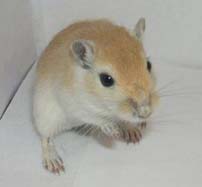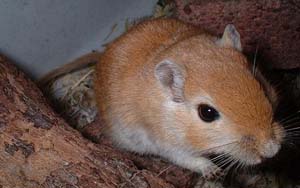Gerbils – Meriones Unguiculatus
Gerbils have a well-deserved reputation as wonderful pets. These sweet-tempered, highly energetic small rodents are a pleasure to watch as they play and work and, with gentle and patient training, they learn to enjoy being held and handled.
Gerbils are native to the dry and sandy areas of Asia, Africa, and the Middle East. They are extremely hardy animals, built for survival. They have lightning quick reflexes, can survive on very little food or water, have strong limbs and nails for digging and burrowing and strong teeth for chewing.
Gerbils were introduced into the United States as laboratory animals and quickly migrated from the laboratory to the home. The most typical gerbil available in the U.S. as a house pet is the Mongolian gerbil. Gerbil coloration ranges from the most common brown (agouti) through grays, blacks and whites.
Gerbils are a wonderful first pet for children or adults. They are easily maintained in a cage or aquarium setting, require habitat cleaning only about once a week, do not smell, can be fed every two or three days and tolerate being handled.
Average Size: Gerbils are larger than mice and smaller than rats or hamsters. They weigh two to four ounces, though they can get much heavier on a constant diet of sunflower seeds, which they tend to overeat. Their bodies are approximately four inches in length with a four inch, hair-covered tail.
 Life Span: The life span of a gerbil is two to four years. Gerbils kept alone typically have a shorter lifespan. Life Span: The life span of a gerbil is two to four years. Gerbils kept alone typically have a shorter lifespan.
Diet: Gerbils need a basic diet of grains and seeds, supplemented with fresh greens, fruits or vegetables several times a week. You may find that food formulated especially for gerbils is less common than foods for other small pets. Gerbils will do very well on hamster or guinea pig food or any “lab chow”. However, gerbils should not eat too many sunflower seeds, which they absolutely love. Sunflower seeds are very high in fat content and can lead to life-shortening obesity. The average gerbil eats about 1/3 ounce of food daily. It’s helpful to place food in a ceramic bowl (they’ll chew up a plastic bowl in no time at all!) In order to keep track of consumption.
Supplement their diet with fresh fruits, vegetables or grasses and plants. However, be sure that any grasses or plants from the outside have not been treated with pesticides or herbicides of any kind.
Although gerbils need very little water and, in the wild, often obtain their total water intake from plant sources, it’s preferable to provide fresh water, using a small animal water bottle (water bottle with a spout, hung upside down in the cage).
Feeding: Plan to feed your gerbils about every two to three days. If you will be away for an extended time, be sure that someone else will feed and water them at least that often.
Housing: Gerbils can be housed in a wire cage, a plastic cage or a glass aquarium tank.
Wire cages are durable and provide excellent ventilation but can create a mess as gerbils burrow and kick bedding out through the wires. In addition, gerbils sometimes chew incessantly on the wires, creating a great deal of noise and in some cases, leading to mouth irritations. Finally, if you have cats, the wire cage may not provide sufficient protection for your gerbils and could cause harm to a cat who tries to claw at the gerbils.
 Plastic cages can be great fun; your local pet store has an endless variety of interesting shapes and connectors so that you can create a gerbil wonderland. Plastic encloses bedding as well so that there is less mess. Be sure that your plastic cage has enough ventilation to keep a good supply of fresh air available for the gerbils. Do remember that gerbils can easily chew through plastic so you must constantly check a plastic cage for escape routes. When cleaning, you should plan to wash all the plastic parts once a month to be sure that the habitat is free from waste buildup. Finally, plastic cages with many connectors can become unstable. Be sure your setup is firmly attached and is out of reach of cats or other animals that could push connectors apart or cause the whole cage to fall and break. Plastic cages can be great fun; your local pet store has an endless variety of interesting shapes and connectors so that you can create a gerbil wonderland. Plastic encloses bedding as well so that there is less mess. Be sure that your plastic cage has enough ventilation to keep a good supply of fresh air available for the gerbils. Do remember that gerbils can easily chew through plastic so you must constantly check a plastic cage for escape routes. When cleaning, you should plan to wash all the plastic parts once a month to be sure that the habitat is free from waste buildup. Finally, plastic cages with many connectors can become unstable. Be sure your setup is firmly attached and is out of reach of cats or other animals that could push connectors apart or cause the whole cage to fall and break.
Glass aquariums with latching, mesh tops can be an ideal habitat. The glass is protective, keeps bedding off the floor and cannot be destroyed by the gerbils. However, you must be sure that the aquarium is large enough, i.e., you need at least a 10 gallon aquarium of two gerbils and should probably move up to a 15 or 20 gallon aquarium for more than two gerbils.
Since a glass aquarium is essentially a box, be sure to create a stimulating environment inside for the gerbils. (See habitat.)
Substrate: Gerbils do not tolerate pine or cedar shavings as bedding. They prefer recycled newspaper, ground corn husks, etc. They usually need just a few inches of covering on the bottom of the cage. If you use more, they may or may not create tunnels in the bedding. It’s a good idea to add alfalfa to the bedding; they will both eat it and use it for pillowing.
Recommended Supplies:
- Cage
- Bedding
- Gerbil Food
- Hanging water bottle
- Ceramic feeding dish
- Furnishings for tunneling, sleeping
Habitat: Gerbils love tunnels and passageways of any kind. They also like to curl up together in a safe, warm, enclose space. Add wooden or plastic “furniture” for them to use or make available a daily supply of cardboard boxes and paper rolls for them to tunnel through, chew on and sleep in. Gerbils also need exercise and will make great use of a running wheel. Plastic wheels are less noisy but tend to get chewed up quickly. Metal wheels are sometimes noisier and there is some danger of tails getting trapped between the wires (although this possibility seems remote; my gerbils have never had a problem). Make your decision about wheels based on your tolerance level for noise or destruction and your gerbils’ preferences.
Temperature/Lighting: Gerbils are very temperature tolerant in the wild but the preferred approach in captivity is normal room temperature; avoid overheating. Although many authorities refer to gerbils as nocturnal, their cage behavior is more likely to be a series of sleep/wake cycles throughout the day and night.
Habitat Maintenance: Clean and replace bedding weekly. Clean cage with soap and water every few weeks. Be sure to remove all soap residue before replacing gerbils in cage.
Signs of a Healthy Pet: Common Health Issues and Red Flags:
Clear eyes
Glossy, smooth coat
No nose irritations
Sleek appearance
Agile, fast movement
Alert, inquisitive
Dull coat
Pink, inflamed area around nose
Diarrhea
Lethargy
Bite marks
Common Problems
In general, gerbils are quite healthy. Health problems often originate with poor housing conditions or feeding habits.[1]
Nose irritations – Gerbils can get nose irritations very easily. The skin around the nose loses hair, becomes pink and swollen and sometimes bleeds. This problem is generally due to sensitivity to bedding material. Experiment with different bedding, especially dust-free varieties. Put a dab of antibiotic on nose twice a day to avoid infection.
Cuts, scrapes – bathe the wound and apply an antibiotic ointment. If two gerbils are fighting, they should be separated and reintroduced gradually, if at all.
Scratching – Gerbils can get mites. Treat with a veterinarian-prescribed powder and clean cage thoroughly.
Coughing, discharge from eyes or nose – Gerbils do sometimes experience respiratory symptoms that can be viral or can be an allergic reaction to housing conditions. Be sure that cage is not in a drafty location. Provide a heat lamp that is directed at one area of the cage for additional warmth. Be sure that the area does not get too warm. Clean cage thoroughly.
Diarrhea – Diarrhea can be cause by a minor stomach upset or by the wrong diet. Try feeding grains only and clean cage thoroughly.
If any of these symptoms persist or worsen, seek treatment from a qualified veterinarian. Remember that a gerbil is a very small creature; it can dehydrate or become overwhelmed by infection very easily.
As with all pets in this category, it is important that you find a veterinarian that practices in EXOTICS – this is critical. The typical small animal practitioner may not have sufficient knowledge in this area. Even this guide is general in nature and should not be used to diagnose your pet.
Sources:
The National Gerbil Society, http://www.gerbils.co.uk/
American Gerbil Society, http://www.agsgerbils.org/
ABC Gerbils, http://www.abcgerbils.com/
Kotter, E, Gerbils, A Complete Pet Owner’s Guide, Barron’s Educational Series, Inc, 1998
Robinson, D.G., Jr., How to Raise and Train Gerbils, TFH Publications, 1967
Weber, William, DVM, Care of Uncommon Pets, Holt, Rhinehart and Winston, 1979
--------------------------------------------------------------------------------
[1] Weber, William, DVM, Care of Uncommon Pets, Holt, Rhinehart and Winston, 1979
|


 Life Span: The life span of a gerbil is two to four years. Gerbils kept alone typically have a shorter lifespan.
Life Span: The life span of a gerbil is two to four years. Gerbils kept alone typically have a shorter lifespan.  Plastic cages can be great fun; your local pet store has an endless variety of interesting shapes and connectors so that you can create a gerbil wonderland. Plastic encloses bedding as well so that there is less mess. Be sure that your plastic cage has enough ventilation to keep a good supply of fresh air available for the gerbils. Do remember that gerbils can easily chew through plastic so you must constantly check a plastic cage for escape routes. When cleaning, you should plan to wash all the plastic parts once a month to be sure that the habitat is free from waste buildup. Finally, plastic cages with many connectors can become unstable. Be sure your setup is firmly attached and is out of reach of cats or other animals that could push connectors apart or cause the whole cage to fall and break.
Plastic cages can be great fun; your local pet store has an endless variety of interesting shapes and connectors so that you can create a gerbil wonderland. Plastic encloses bedding as well so that there is less mess. Be sure that your plastic cage has enough ventilation to keep a good supply of fresh air available for the gerbils. Do remember that gerbils can easily chew through plastic so you must constantly check a plastic cage for escape routes. When cleaning, you should plan to wash all the plastic parts once a month to be sure that the habitat is free from waste buildup. Finally, plastic cages with many connectors can become unstable. Be sure your setup is firmly attached and is out of reach of cats or other animals that could push connectors apart or cause the whole cage to fall and break.